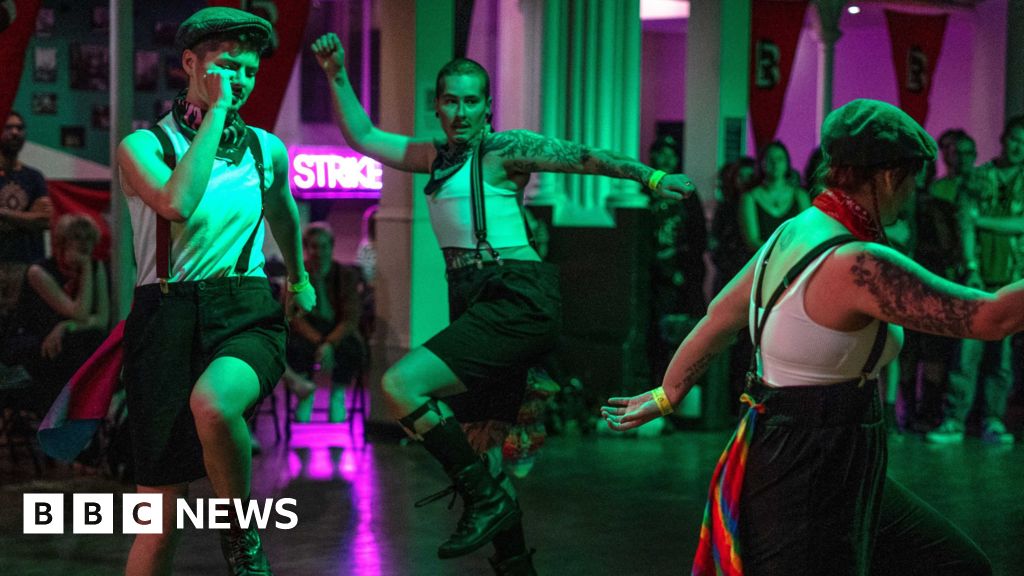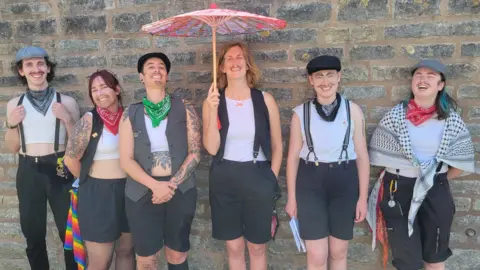 Rachel Beckwith
Rachel BeckwithWhen you think of the English tradition of Morris dancing, you might not picture a group of young, gender non-conforming, drag kings who dress like “chimney sweeps” – but that will be because you’ve not seen Molly No-Mates.
The Bristol team – or side – represents the changing face of Morris, a tradition in which men no longer make up the majority of participants for the first time in UK history.
For co-founder Scarlett Hutchin, it was a counter protest outside a drag queen story time in Bristol that sparked the idea of a queer-friendly Morris side.
The events see a drag queen reading a book to children with the goal of promoting reading and diversity, but some have seen backlash from the public.
“I was texting with my friend from my Morris team and I was just like, ‘what would really improve the situation? Morris dancing’,” says Scarlett.
“One of the traditions of Molly [a type of Morris] is to dance to just singing and that’s what we do. And we can have these dances that we can take to the protests that don’t require instruments and don’t require things that are offensive weapons.
“It gives us scope to make our values and our point of view very visible, because when you have songs, you have words.
“Pretty much all of our songs are in some way feminist or queer or leftist.”
Morris dancing is a form of traditional English folk dance that takes a variety of styles depending on where the group has come from.
For example, Border Morris, originating in the Welsh border counties of Shropshire, Herefordshire and Gloucestershire, features performers who wear tatter coats and often paint their faces or use other forms of disguise.
By contrast, Clog Step is a dance style with percussive footwork and fine timing.
Scarlett feels Molly No-Mates is part of the “cultural moment” Morris is experiencing, and points to last year’s Brit Awards where Stroud-based group Boss Morris danced on stage with Wet Leg, who won Best New Artist and Group of the Year.
“One of the things that’s bringing a lot of people kind of back to folk… is people want to have some kind of culture,” Scarlett says.
“And there’s this idea that England doesn’t have any culture which is just not true. It’s just that it’s really neglected.”
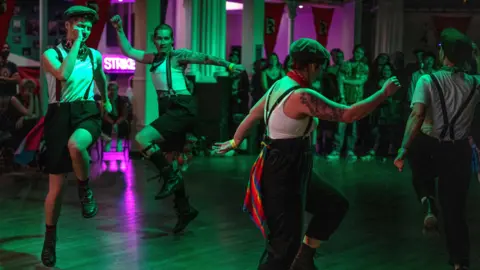 Jack Witek
Jack WitekAccording to the 2023 Morris Census, the proportion of female members in Morris in the UK had risen from 46% in 2014 to 50.6% in 2023.
In 2020, its questions were tweaked to include the number of “non-binary/other” members.
An estimated 0.8% of UK sides’ members were reported in this category in 2023, up from 0.5% in 2020.
Molly No-Mates, which formed in May 2023 in north Bristol, had just two members when it started – hence the “no-mates”. Now they number 10 and are around “80% non binary or other”.
“It feels like we’re kind of bringing visible queerness into spaces that don’t always have it that much,” Scarlett says.
She describes their outfits as looking like “19th Century chimney sweeps”, donning black shorts or trousers, a white top, braces and a flat cap.
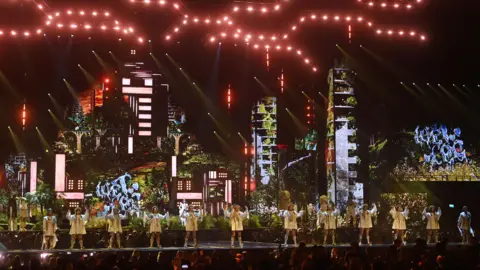 EPA
EPAColin Andrews is an administrator at the Morris Dances & Teams Database and started teaching Morris dancing in 1990.
The site, which started in early 2018, provides an easily searchable database of all Morris teams worldwide.
“From about the mid 20s right the way through to the early 70s, Morris was regarded as being exclusively male,” he says.
“The Squire Elect [incoming leader] for the Morris Ring is a woman… it’s moving away from being gender specific.
“I would say probably over the past five years many of the male-only Cotswold Morris sides have gone mixed, and that basically was it’s either a case of going mixed or folding… [they] just weren’t getting enough new new members in.”
Morris is an “evolving tradition”, Colin says, and he thinks it’s interesting to see teams develop their own interpretations of the dance.
“I think the question is whether these innovations will continue or whether they will just last as long as that particular team lasts,” he says.
“But I think it’s a good thing that people try experimenting with different things.”
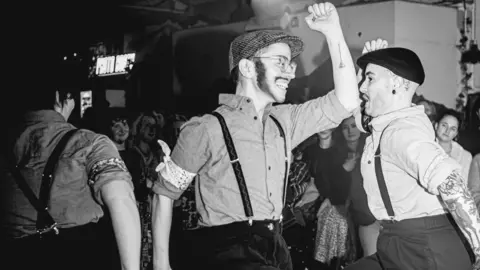 Soft Butch/Sophia Stefellé
Soft Butch/Sophia StefelléSince Molly No-Mates started, Scarlett says the side has received a “really positive response” from a lot of traditional teams.
“In August we were dancing at Northgate Folk Festival in Chester… and there was a lovely traditional old, white men’s team and they said they’d arrived several hours early to see us.”
One of the most distinct elements of traditional Molly dancing is the use of cross-dressing, according to the English Folk Dance and Song Society.
At least one – but sometimes several – of the team members dress in women’s clothing.
They say 19th Century Molly groups took pride in the appearance of their crossdressing “Moll”, competing amongst themselves to see who could produce the best dressed – and this is probably where the name Molly comes from.
In the past, the term molly was an offensive word aimed at gay men, or men who carried out tasks considered to be women’s work, such as cooking or clothes washing.
In the 18th and early 19th centuries, molly houses were locations where “mollies”, or queer men, met for companionship and sex.
They could be in pubs, taverns, inns or coffee houses.
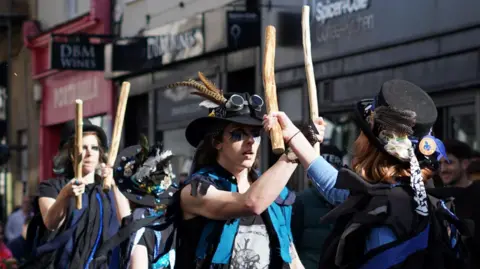 Akhilesh Mistry
Akhilesh MistrySam Murphy, who identifies as gender fluid, is Squire of Bristol-based Border Morris team Kittiwake.
They took up Morris dancing despite having no family background in it.
“The key things that you’d need to enjoy are moving around a lot and looking a bit funny,” Sam advises aspiring beginners.
“The people I’ve met from it have been just the most lovely people.
“There’s no gatekeeping, [there’s no] ‘You’re not committed enough, so you can’t do this’. It’s very supportive.
“And certainly in the circles that I’ve been in… there is more acceptance and openness, and people are more comfortable expressing themselves in things outside the gender binary.”
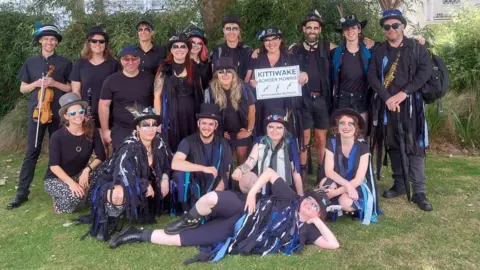 Rachel Beckwith
Rachel BeckwithThe three main organisations in the UK that support Morris and traditional dance teams are The Morris Federation, The Morris Ring and Open Morris.
They come together as the Joint Morris Organisations to discuss issues that affect all of their members.
Nigel Strudwick, current Squire of the Morris Ring, says the Morris world is changing and the Morris Ring is “delighted” to see the traditions move forward.
“We welcome everyone who would like to try out Morris dancing regardless of background, and it’s good to see new teams being formed to cater for those who might otherwise have felt there is nothing in the Morris for them.
“Long may this continue.”

